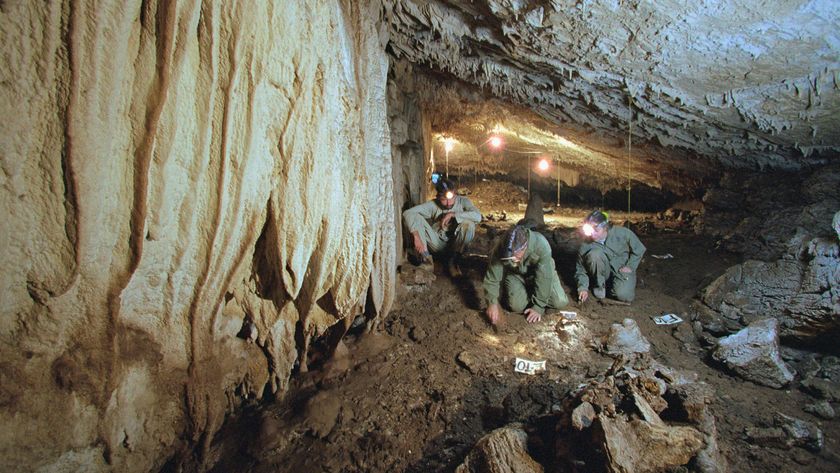The Lore and Lure of Ley Lines

Many people believe that a grid of earth energies circles the globe, connecting important and sacred sites such as Stonehenge, the Egyptian Pyramids, and the Great Wall of China.
If you plot these and other sites on a map, a curious thing becomes apparent: Many of them can be connected by straight lines. Were these monuments and sacred sites specifically built at those locations by ancient people with lost knowledge of unknown earth energies especially strong along these "ley lines"?
History of ley lines
People have often found special significance in the unusual landmarks and geological features surrounding them. High mountain peaks and majestic valleys may be viewed as sacred, for example, while deep, dark caves have often been considered the domain of the underworld. The same is true for roads; in 1800s on the British Isles many people believed in mysterious "fairy paths," trails connecting certain hilltops in the countryside. It was considered dangerous (or, at the very least, unwise) to walk on those paths during certain days because the wayward traveler might come upon a parade of fairies who would not take kindly to the human interruption.
Philip Carr-Gomm and Richard Heygate describe the origin of ley lines in their "Book of English Magic": "Alfred Watkins, a landscape photographer in Herefordshire, noticed that ancient sites seemed to be aligned with others nearby. His idea was that our ancestors built and used prominent features in the landscape as navigation points. These features included prehistoric standing stones and stone circles, barrows and mounds, hill forts and earthworks, ancient moats, old pre-Reformation churches, old crossroads and fords, prominent hilltops and fragments of old, straight tracks. Watkins went on to suggest that that the lines connecting these ancient sites represented old trackways or routes that were followed in prehistoric times for the purposes of trade or religious rites, and in 1921 he coined the term 'ley lines' to describe these alignments."
Watkins himself did not believe that there was any magical or mystical significance to ley lines. However, the authors note, "The idea that there is a hidden network of energy lines across the earth ... fired the imagination of the burgeoning New Age movement, and dowsers in particular became keen on detecting leys with dowsing."
Because of this New Age interest, ley lines rose from mundane origins to an entire field of study, spawning books, seminars, and groups of ley line enthusiasts who gather to discuss, research, and walk the lines. Ley lines have also been incorporated into a variety of otherwise unrelated paranormal subjects, including dowsing, UFOs, Atlantis, crop circles and numerology.
Science and pseudoscience
You won't find ley lines discussed in geography or geology textbooks because they aren't real, actual, measurable things. Though scientists can find no evidence of these ley lines — they cannot be detected by magnetometers or any other scientific device — New Agers, psychics and others claim to be able to sense or feel their energy.
Watkins's original idea of ley lines is quite valid and rather intuitive; archaeologists have long known that, on a local and regional scale, roads tend to be built in more or less straight lines, geography allowing, and since a line is the shortest distance between two points it makes sense that important sites in a given culture would often be aligned, not randomly placed.
Ley line experts cannot agree on which "sacred sites" should be included as data points. Some internationally known ancient sites are obvious choices, such as England's Stonehenge, Egypt's Great Pyramids, Peru's Machu Picchu ruins, and Australia's Ayers Rock. But on a regional and local level, it's anyone's game: How big a hill counts as an important hill? Which wells are old enough or important enough? By selectively choosing which data points to include or omit, a person can come up with any pattern he or she wishes to find.
With literally tens of thousands of potential data points around the globe, it is little wonder that ley lines can be found everywhere. Possible points include castles (or even places with "Castle" in the place name); moats; churches; ancient mounds; ancient stones; wells; crossroads; special groups of trees; and so on. Indeed, there are so many potential points that by chance alone connecting them will form many straight lines and seemingly significant patterns. For example, the Great Wall of China is thousands of miles long, and surely some parts of the wall will connect with many imaginary lines drawn across the globe from another important sites.
A good analogy is that ley lines exist in the same way that astrological constellations exist. You can draw (or imagine) lines connecting certain stars to form the horns of the Taurus constellation, the scales of the Libra sign, or the Big Dipper. But that doesn't mean that those points were placed there to make that pattern. The way the patterns of stars are grouped and connected is arbitrary and artificial, not guided by anything in nature or reality; they are patterns our brains impose on the world around us. The only meaning is that which we bring to it. [Related: Pareidolia: Seeing Faces in Unusual Places]
In most cases, the locations of these supposedly significant ancient sites were not dictated by any sort of unknown earth energies but by practical matters such as access to the building materials. Furthermore, many of these places are natural features, such as Mount Everest and Ayers Rock; no one built or placed those locations there based on knowledge of earth energy lines. And of course, the ancient builders of Stonehenge could not have known about the existence of Everest, Machu Picchu, or other sites, and therefore could not have intentionally built the monument to intersect with the alleged ley lines emanating from those sites.
Whether ley lines exist or not, the fact that many people believe they do provides insight into the human brain's amazing capacity for finding patterns in the world around us.
Benjamin Radford is deputy editor of Skeptical Inquirer science magazine and author of six books including Lake Monster Mysteries: Investigating the World's Most Elusive Creatures. His website is www.BenjaminRadford.com.
Sign up for the Live Science daily newsletter now
Get the world’s most fascinating discoveries delivered straight to your inbox.













